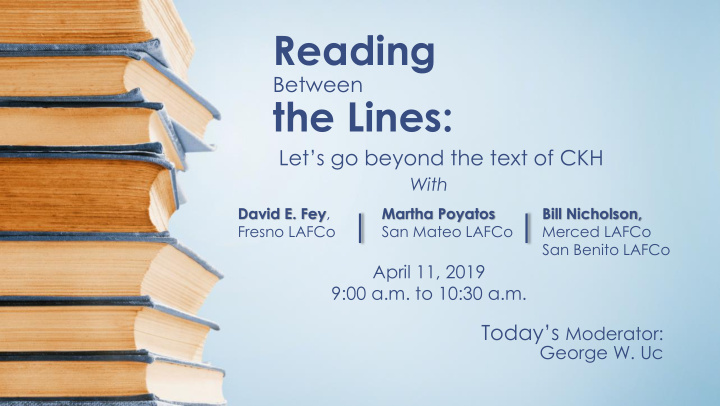



Reading Between the Lines: Let’s go beyond the text of CKH With David E. Fey , Martha Poyatos Bill Nicholson, Fresno LAFCo San Mateo LAFCo Merced LAFCo San Benito LAFCo April 11, 2019 9:00 a.m. to 10:30 a.m. Today’s Moderator: George W. Uc
Agenda • Welcome • Ice breaker Panelist Presentation • – Local Chemistry (David) – Case Study (Martha) – Caution Points / Indirect Challenges (Bill) • Conclude by 10:25 a.m.
Ice Breaker – Meet and Greet Pick 2 ,or take all 3: • How long have you been with LAFCo? • How did you get to LAFCo? • Any topic you want to hear about?
Local Chemistry: f f (Practice) = P 3 • Policy • Process • Politics
Local Chemistry: f f (Practice) = P 3 • Policy “Discretion,” noun • individual choice or judgment • Process • power of free decision or latitude of • Politics choice within certain legal bounds • the quality of having or showing discernment or good judgment • ability to make responsible decisions
Local Chemistry: f f (Practice) = P 3 • Policy – There’s CKH, then there’s local policies and practices • Process – How do you do things? – How do issues come your way? • Politics – Commissioners – Local agencies – Power brokers
Case Study: Citizens for Responsible Open Space v. San Mateo LAFCo & Midpeninsula Regional Open Space District Key Points: • LAFCo Proposal: A 144,000 acre Annexation to MROSD • Inhabited Annexation / Community Outreach • Protest Proceedings • Lessons Learned
Caution Points / Indirect Challenges CKH Terminology • Multi Agency Communication • – Land Use Authorities (Cities and Counties) – Special Districts: Municipal Service Providers Procedural Limitations • – Example: GC 56133 – New Rural Development vs. “…existing and impending threats to health and safety.” – State Water Resources Control Board
LAFCO Terminology Term Comparison Examples Why aren’t “Conducting Authority “Commission proceedings”(GC • • 56028) - LAFCOs perform ALL! Proceedings” (GC 56029) also.. “Municipal Service Review” • When is a “service review”(GC 56430) • a… “Disadvantaged Unincorporated • When is a Disadvantaged Community • Community” (GC 56033.5) (WC 79505.5) a… When is a “Consolidation” (GC 56030) • v s. a “Merger” (GC 56056) •
LAFCo Terminology - Contrasting Points How can an area with 20 residents be considered • “uninhabited” (GC 56079.5)? If you can’t protest a LAFCO approval as a • registered voter (because you live in an “uninhabited” annexation area), you get to protest as a “landowner” based on the value of your land (GC 57077.3(b)(1)(b)). – At least your home on a one-acre lot gives you more voting power (more assessed value) than a neighboring vacant (uninhabited) one-acre lot - Photo Source: Lands of America 2019. Right? Any other examples from the panel or audience??? •
Multi Agency Communication Land Use Authorities Cities – General Plan, Specific Plan, Zoning Code, Local Hazard Mitigation Plan & Safety • Element Counties - General Plan, Community Plan, Zoning Code, Ag Land Preservation Contracts, • Local Hazard Mitigation Plan & Safety Element Non-Land Use Authorities: Municipal Planning Organizations/Councils of Governments – Sustainable Community • Strategy, Regional Transportation Management Plan Special Districts – i.e. Community Service Districts historically identified as having powers • most closely resembling a city – but lacking land use power Local Agency Formation Commissions – 56886 limits LAFCOs from directly regulating land • use, property development, or subdivision requirements – Can LAFCOs “indirectly” regulate land use?
Procedural Limitations GC 56133 – Background and context a) Since 1994, service extensions outside jurisdictional boundaries require LAFCO approval. b) Within jurisdictions SOI : In anticipation of a later “change of organization” (typically annexation). c) Outside jurisdictions SOI: To respond to an existing or impending threat to public health and safety. d) This subsection addresses procedures for processing by LAFCO. e) Provides exemptions from LAFCO review: non-potable water delivery, surplus agricultural water transfers, publicly-owned electric utilities, where the service was extended prior to 2001, and where two or more existing public agencies provide the same service at the same level of service contemplated by the agency, and agree to allow the other agency to extend the service inside their jurisdiction for some reason.
GC sec. 56133 – Helpful Tips What is it called? How is it acted upon? Extraterritorial Extension Approve an “Extension” • • Outside Agency Service Approve a “Proposal” or “application • • Out-of-Boundary Service Approve a “contract” or “agreement” • • (i.e. waiver of right to protest annexation, or a pre-annexation agreement)
Recent Trends from the State Water Resources Control Board (SWRCB) Passage of SB 1263 effective in 2017 gives • the SWRCB authority to approve new public water supply permits before local agencies issue development permits. Public water systems serve at least 25 people • at least 60 days during the year, but less than 200 people To avoid on-site wells and possibly on-site • small water treatment systems and associated monitoring requirements: the Water Board is to evaluate the feasibility of connecting the new development to an existing public water system within three miles of the proposed new public water system.
QUESTIONS TO PONDER How many agencies have a SOI boundary extending 3 miles past their city or • district boundary? Assuming the extension is to a use outside the SOI, there has to be an existing • or impending threat to public health or safety under GC 56133(c). Traditionally an “existing or impending” threat to public health or safety was • limited to existing projects where a well is contaminated or it went dry. How can a new development proposal that must meet all local and state • standards be considered an impending threat to health and safety by LAFCO?
Comments or Questions Thank you!
Recommend
More recommend